Southwest Virginia is home to the headwaters of the most biologically diverse population of mussels in the world, but human impacts are facing them with new challenges.
By Cassidy Cianciolo
When thinking of extraordinary places that are home to unique wildlife and curious creatures, Southwest Virginia is not what typically comes to mind. But our corner of the southeastern United States is fantastically one of the most biodiverse places in the world. The biodiversity, meaning the variety of living species, of Earth is astronomical — there are an estimated 8.7 million species on our planet. We’ve only discovered a fraction of the number, with about 1.2 million named species. While there is still much to be discovered, there is also much to be protected. Facing the threat of extinction, the most imperiled group of animals lives just outside the backyard of Southwest Virginians: the freshwater mussel.
Freshwater mussels have been affectionately — and accurately — nicknamed “nature’s Brita filter”. For certain species, a single mussel can filter about 15 gallons of water in a day. Freshwater mussels have incredible ecological importance by creating beneficial outputs for their environment. In addition, they also aid in human well-being, producing what’s referred to as “ecosystem services”. Some of these services include cleaning freshwater systems by removing sediment, phosphorous, fecal bacteria, heavy metals, and agricultural runoff. Simply put, mussels make water cleaner and healthier for other species, including humans.
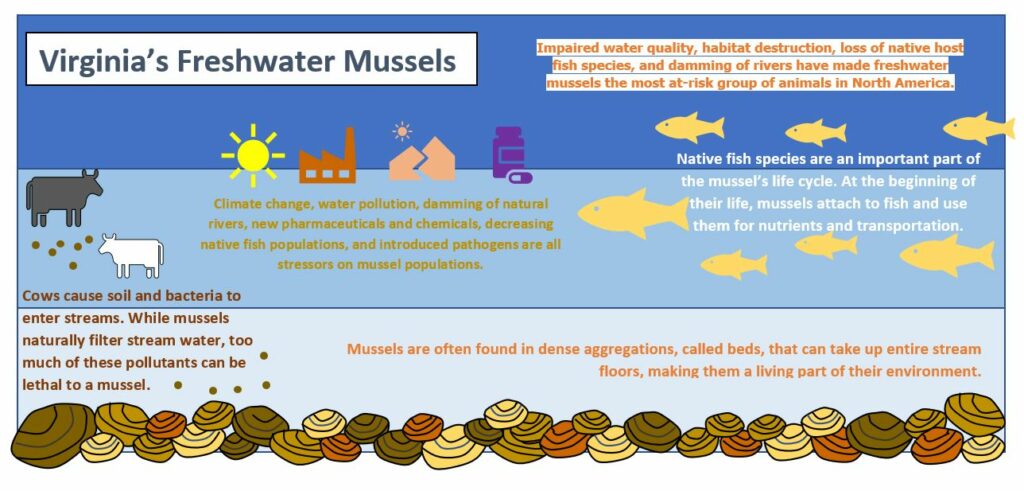
When numerous species of mussels are living and reproducing in a river, it indicates a healthy aquatic system that is usually equipped with good fishing and robust environments for other aquatic life and wildlife. “If they weren’t there, the overall particle or sediment load would not be filtered, they’re also uptaking nutrients, and you’d have a reduction in the ecosystem services.” Dr. Jess Jones, a mussel restoration biologist and associate professor at Virginia Tech, informed me. “Mussels in a healthy system comprise most of the biomass that is out there. An overall reduction in biomass, which is providing food for all kinds of species within the ecosystem… Those are the kinds of things that we’re just starting to learn about. What is their true role?”
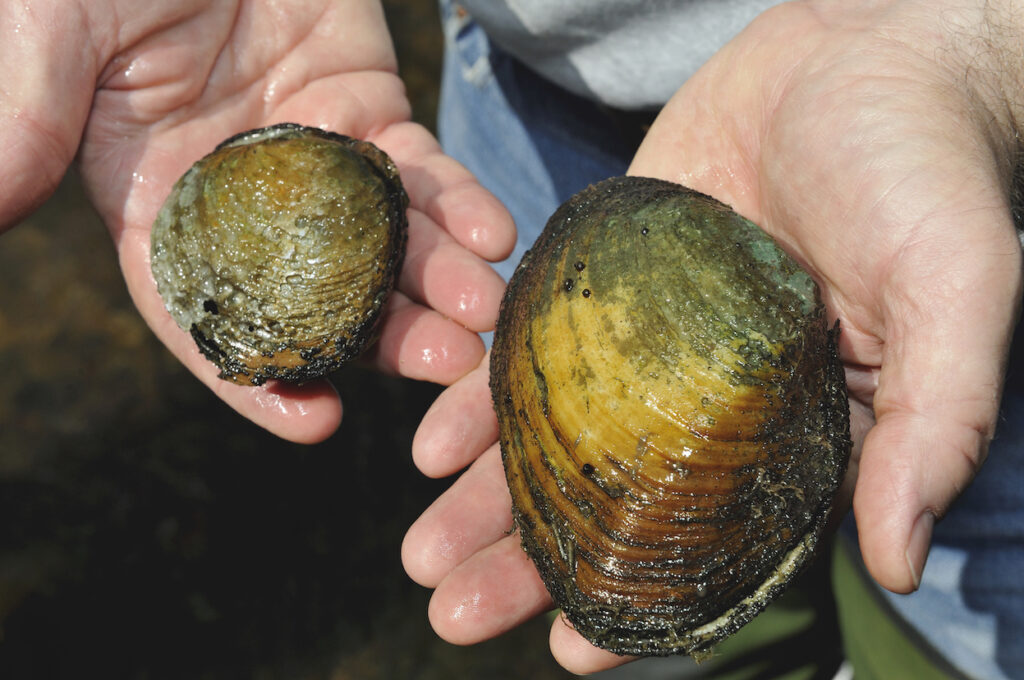
In all of Europe, there are only 12 freshwater mussel species. The United States has roughly 300 species, with 77 species residing in Virginia. Southwest Virginia, in particular, has 54 species of freshwater mussels, making it a global biodiversity hotspot for the mighty bivalves.
The Clinch River, with its headwaters forming near Tazewell, Virginia, contains the nation’s largest concentration of rare freshwater animals — many of which are at risk of becoming extinct. In particular, mussels face more threats now than ever before. A long history of human interference in their freshwater homes has culminated into significant threats to their very survival. Dams, diversion of streams for agriculture, sediment-laden runoff, and wetland conversions are just a few causes of overwhelming amounts of pollutants being introduced into their freshwater homes. Climate change also adds another layer of uncertainty to the mollusk’s future.
Freshwater mussel populations in the southeastern U.S. have taken a major hit in recent years with periodic mass die-offs, most of which have taken place in the Virginia side of the Clinch River. Perhaps the most worrisome part is that we still don’t know exactly why it’s happening. While die-offs have been seen before, none have been quite this calamitous. One of the Clinch’s most abundant mussel species, the pheasantshell, has seen a drop in over 90% of their numbers since 2016. Total populations of the river’s mussel species have fallen by half.
“There’s no doubt that habitat and water quality degradation declines mussel populations. Even that is still very complicated,” said Dr. Jones. “Being able to pinpoint a true, definitive cause or source on mussels…they’re complex and dynamic systems. Teasing out which stressors are definitively causing die-offs is a very challenging thing to do.”
Over 7% of native freshwater mussels have already gone extinct. One of the leading theories for the recent declines is a novel pathogen introduction. When the rivers aren’t healthy due to many different stressors, such as water pollution, changing the hydrology through damming, cows in streams causing increases in bacteria and sediment, invasive species taking resources, and even warmer water from climate change, it essentially breaks down the mussels’ “immune system”. This makes them more susceptible to pathogens and disease that may have entered the waterways.
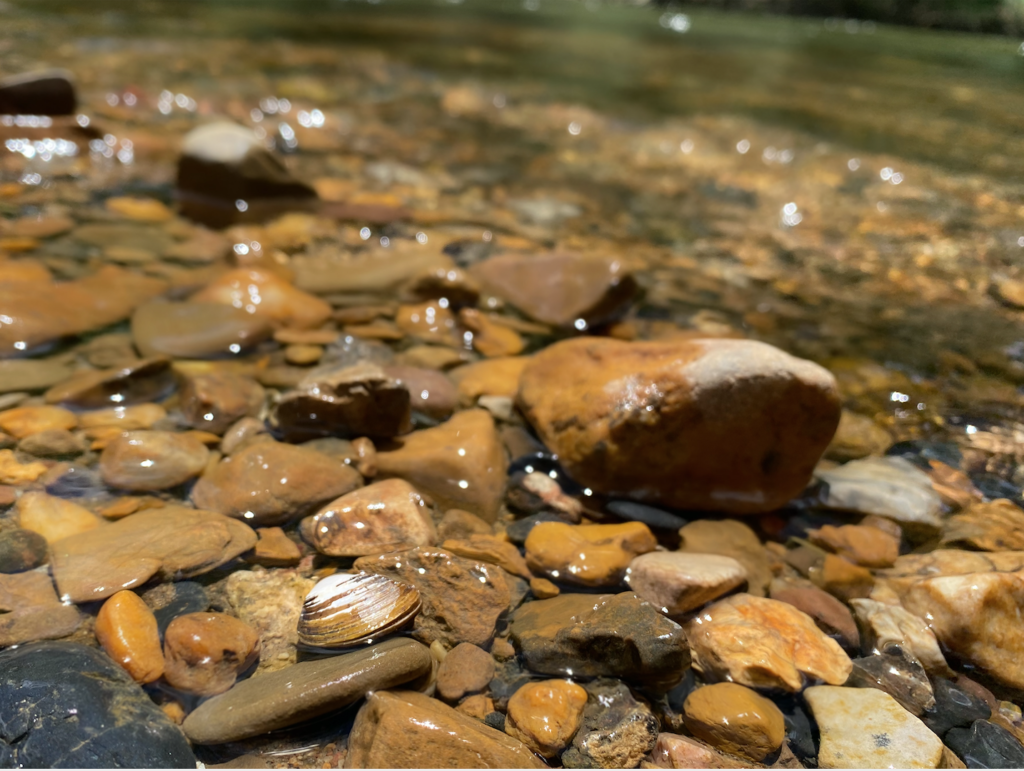
Freshwater mussel conservation has a special history in Blacksburg. Dr. Richard Neves, professor emeritus at Virginia Tech and former president of the Freshwater Mollusk Conservation Society, convened a mussel die-off workshop in 1982. It was there that the need for a hatchery system was decided, leading to the creation of the first freshwater mussel conservation laboratory. Constructed in 2002, the Freshwater Mollusk Conservation Center (FMCC) at Virginia Tech is a flagship research center that paved the way for more than 20 mussel hatcheries located across the country.
While mussel ecologists at the center have plenty of ongoing research projects, the FMCC has two primary focuses: (1) figuring out causes of mussel population decline and (2) creating a hatchery support system that works toward understanding the role of mussels in their ecosystem. Dr. Tony Timpano, a research associate involved with the FMCC, is investigating the former.
“Everything that happens on a landscape has the potential to negatively impact life downstream… we’re trying to take some potential water quality factors or contaminants and trying to see if there’s a possibility that they’re affecting mussels,” Dr. Timpano explained. The research specifically focused on three trace metals: copper, nickel, and zinc – all of which are priority pollutants on EPA’s water quality list. However, EPA does not have a combined “cocktail” limit for the three pollutants. The research explored if those elements together cause amplified toxicity in freshwater mussels.
“We tried to test the hypothesis: if it’s true that multiple metals in combination are more toxic than any one in isolation, we should see a greater toxic effect — which is exactly what we saw… It’s kind of like having multiple viruses all at once.”
Below is a graph from part of Dr. Timpano’s research showing how three metals (Copper (Cu), Nickel (Ni), and Zinc (Zn)) affect mussel growth.
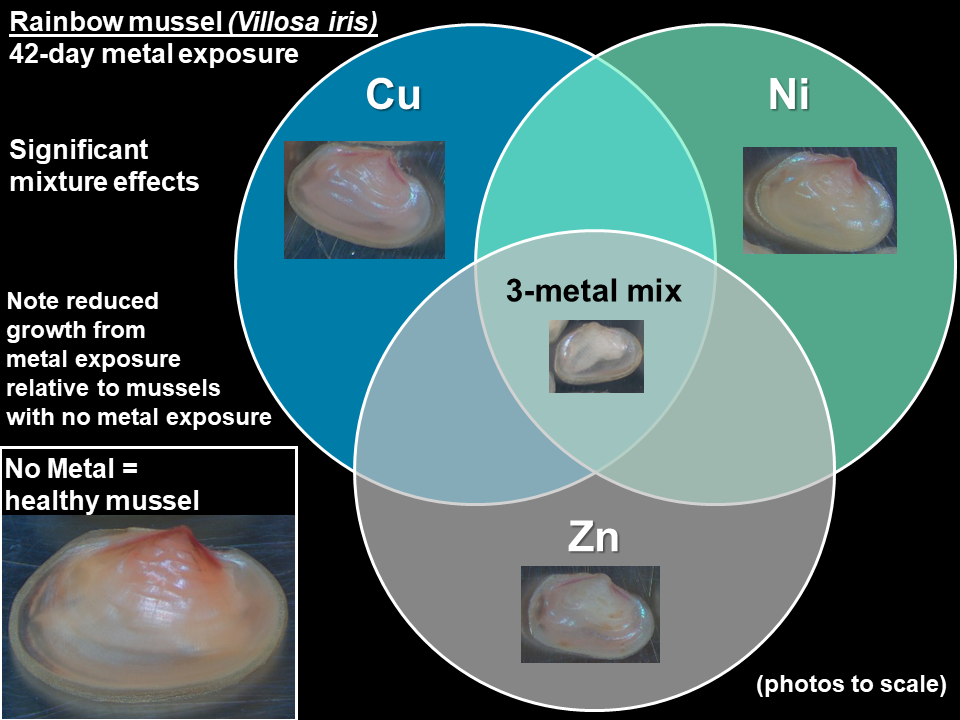
Unfortunately, there is a disparity of biodiversity and protected lands. In a research article from 2015, “US Protected Lands Mismatch Biodiversity Priorities”*, scientists highlight the disconnect between threatened and imperiled species and lands that are federally and locally protected. The majority of protected lands in the nation are found in the West; however the priority vulnerable species are largely in the Southeast. Organizations like the New River Land Trust, Blue Ridge Land Conservancy, and The Nature Conservancy advocate for more protections on our streams and rivers for the future of their biodiversity.
One way to help secure the future of our mollusk neighbors is engaging and being interested in their communities. “One of the sole lacking components of managing freshwater systems sustainably is that there’s no money or interest in monitoring those systems… mussels and aquatic insects aren’t as charismatic as big fishes but [they are] very important to water quality aspects,” advocated Dr. Timpano.
From when he first assisted with research studies on mussels, Dr. Jones was captivated by what was underneath the surface. “It was this whole other world I never knew existed, and I started seeing the different species… I was blown away.” As for what any Virginian can do in their day-to-day lives to help these river dwellers, Dr. Jones had an emphatic reply. “I would recommend the first step would be to find someone and go to a river and see them firsthand. Put on a mask and snorkel — get out and look and see where they live. It gives you a sense of why water quality matters.”
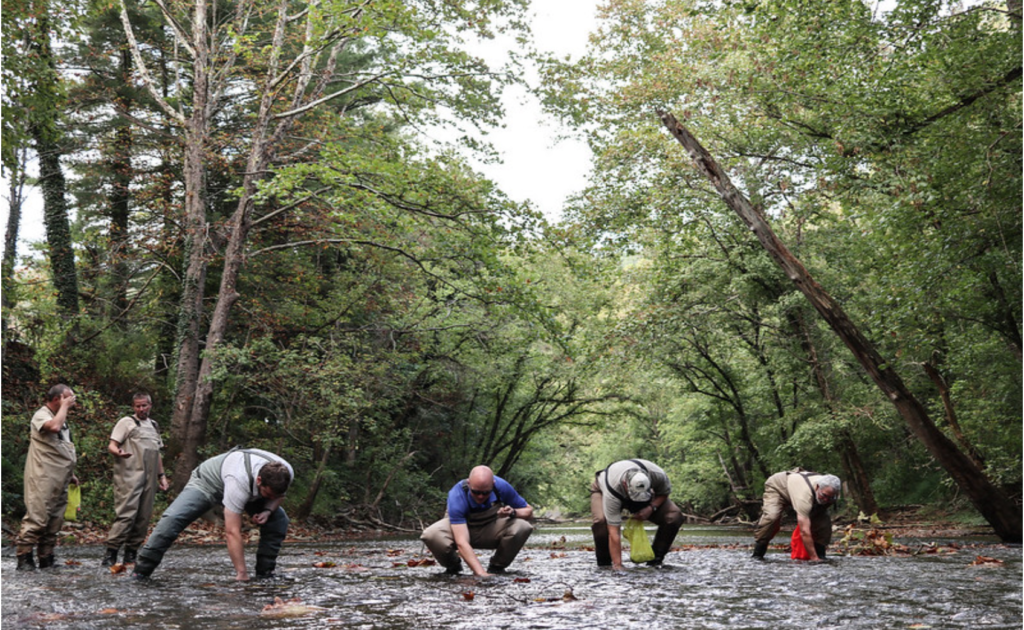
“Once you do that, you can educate others and take others out, get involved with events that take school children out. When they experience that firsthand, making them aware that mussels are cool and need help… that’s half the battle right there.”
Special thanks to Dr. Jess Jones and Dr. Tony Timpano for their time and efforts.
If you’d like to learn more about mussel conservation, you can listen to Virginia Water Radio’s episodes here and here.
* Jenkins, C. N., Houtan, K. S., Pimm, S. L., & Sexton, J. O. (2015). US protected lands mismatch biodiversity priorities. Proceedings of the National Academy of Sciences, 112 (16), 5081-5086. doi:10.1073/pnas.1418034112
